After Philae separated from its mothership yesterday, the OSIRIS imaging system on Rosetta shot a series of images following the lander’s descent to its destination on Comet 67P/Churyumov-Gerasimenko.
Separation occurred onboard the spacecraft at 08:35 GMT (09:35 CET), with the confirmation signal arriving on Earth at 09:03 GMT (10:03 CET).
This is how Philae appeared to Rosetta’s OSIRIS narrow-angle camera a couple of hours after separation, at 10:23 GMT (onboard spacecraft time). This image shows details of the lander, including the deployment of the three legs and of the antennas.
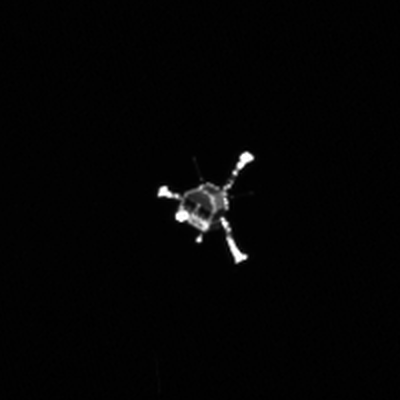
The departure of Philae on 12 November 2014, as seen with OSIRIS NAC on Rosetta at 10:23 GMT (onboard spacecraft time). Credits: ESA/Rosetta/MPS for OSIRIS Team MPS/UPD/LAM/IAA/SSO/INTA/UPM/DASP/IDA
And here is how the descent proceeded:
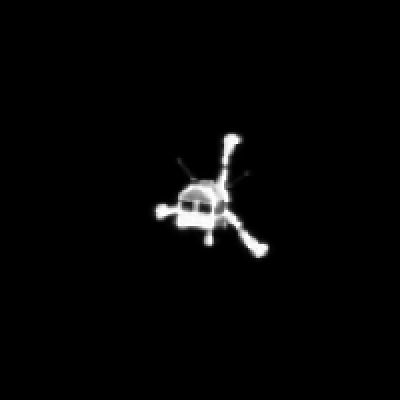
Series of images form OSIRIS NAC showing Philae’s descent to the surface of a comet. They were taken on 12 November 2014, between 10:24 and 14:24 GMT (onboard spacecraft time). Credits: ESA/Rosetta/MPS for OSIRIS Team MPS/UPD/LAM/IAA/SSO/INTA/UPM/DASP/IDA
This series of images showing Philae’s descent to the surface of the comet were taken with the OSIRIS narrow-angle camera between 10:24 and 14:24 GMT (onboard spacecraft time). More images showing Philae closer to the surface are still to be downloaded.
Here is another image, this one taken with the OSIRIS wide-angle camera, which shows the position of Philae (circled) at 14:19:22 GMT (onboard spacecraft time).
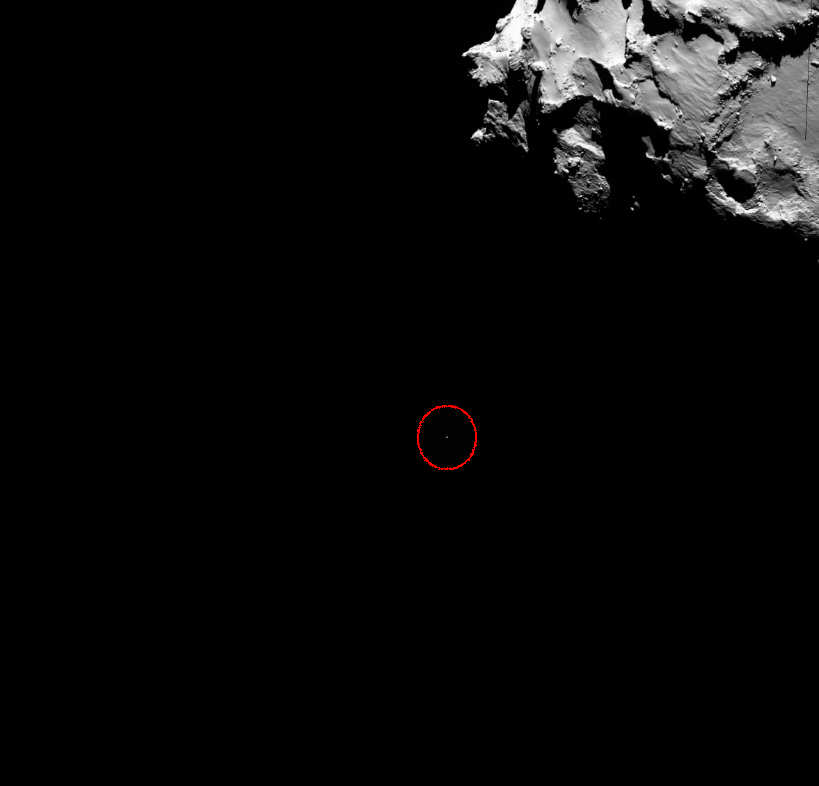
Philae descending to the comet, as seen by OSIRIS WAC on Rosetta, on 12 November 2014 at 14:19:22 GMT (onboard spacecraft time). Credits: ESA/Rosetta/MPS for OSIRIS Team MPS/UPD/LAM/IAA/SSO/INTA/UPM/DASP/IDA
And this is where Philae made its first touchdown on Comet 67P/C-G. It is thought that Philae bounced twice before settling on the surface of the comet, and the location of the first touchdown point is marked in this image from the OSIRIS narrow-angle camera (which was taken from a distance of 50 km on 2 September 2014, prior to landing).
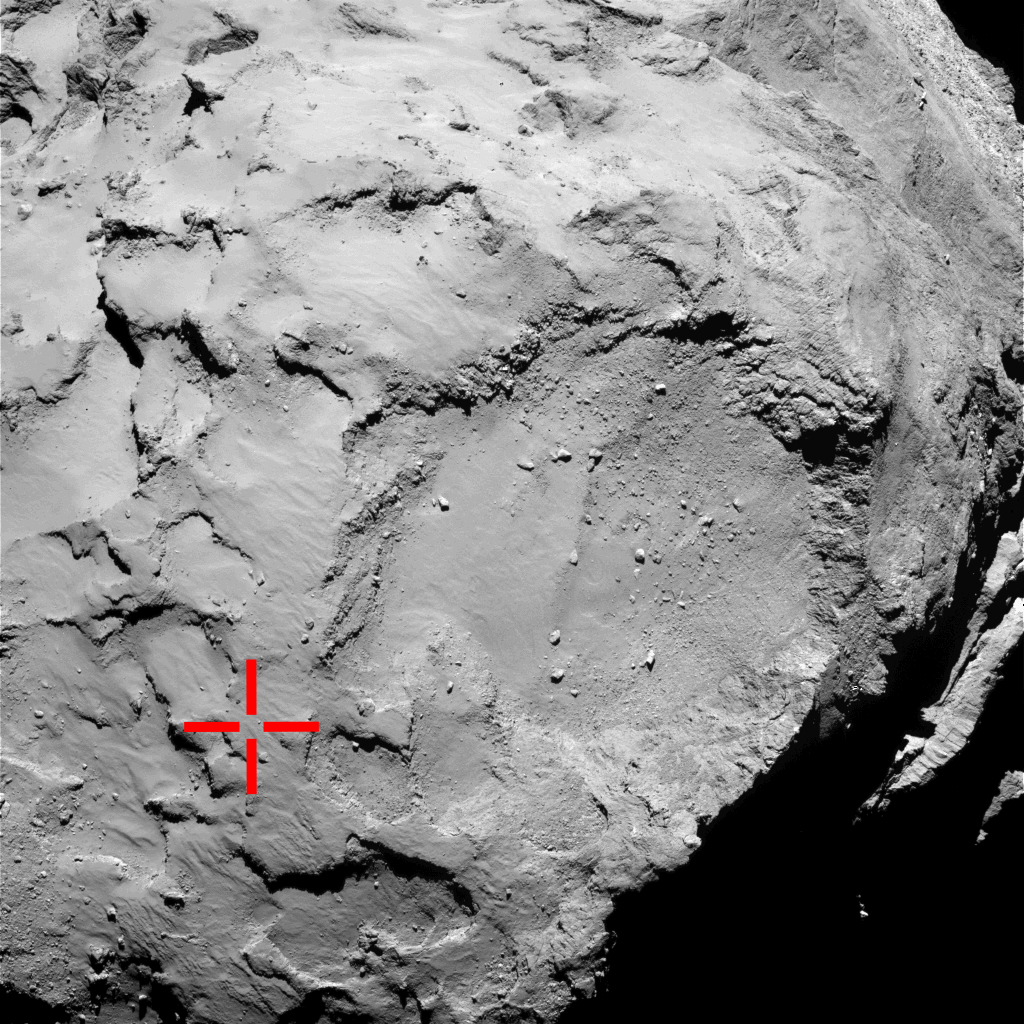
The location of the first touchdown point of the Philae lander on Comet 67P/C-G, marked on an image from Rosetta’s OSIRIS narrow-angle camera taken from a distance of 50 km on 2 September 2014. Credits: ESA/Rosetta/MPS for OSIRIS Team MPS/UPD/LAM/IAA/SSO/INTA/UPM/DASP/IDA
Philae’s first touchdown point is also marked in this image taken with the OSIRIS narrow-angle from a distance of 30 km on 14 September 2014 (prior to landing).
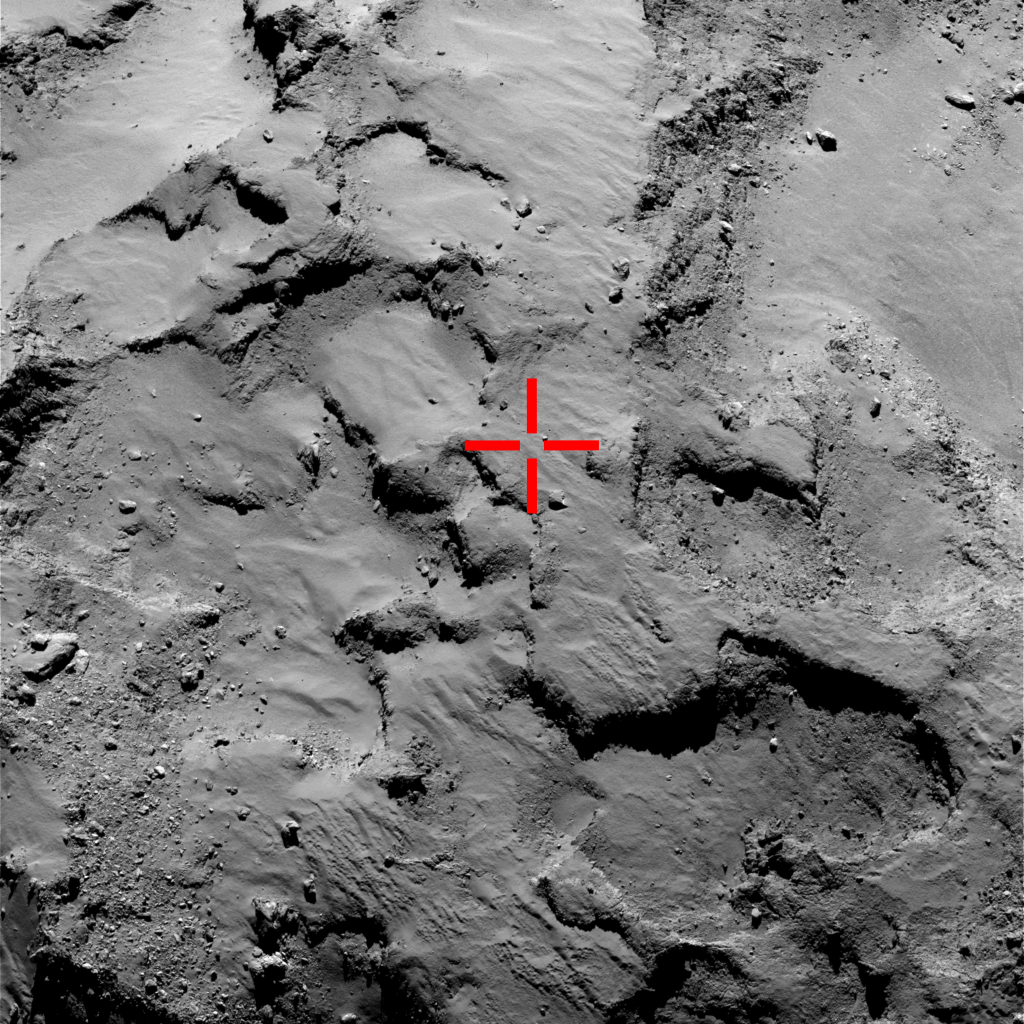
The location of the first touchdown point of the Philae lander on Comet 67P/C-G, marked on an image from Rosetta’s OSIRIS narrow-angle camera taken from a distance of 30 km on 14 September 2014. Credits: ESA/Rosetta/MPS for OSIRIS Team MPS/UPD/LAM/IAA/SSO/INTA/UPM/DASP/IDA
Finally, here is a five-image montage of OSIRIS narrow-angle images that is being used to try to identify the final touchdown point of Rosetta’s lander Philae. The red cross marks the first touchdown point.
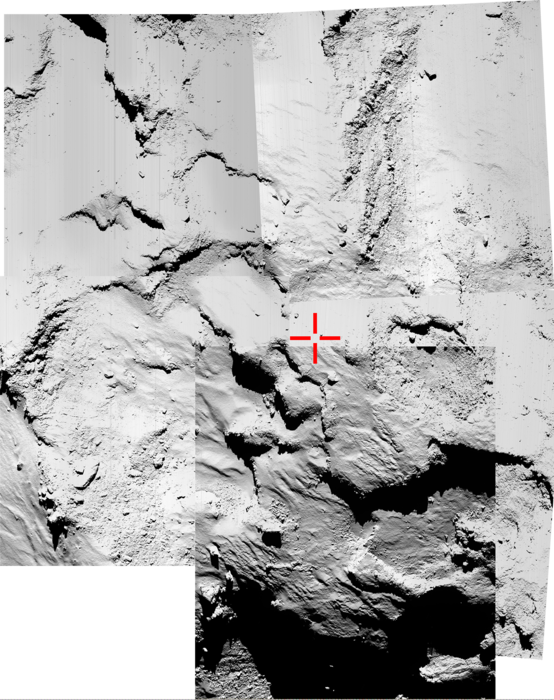
Five-image montage of OSIRIS NAC images taken around the time of landing on 12 November 2014, when Rosetta was about 18 km from the centre of Comet 67P/C-G. The red cross marks the first touchdown point. Credit: ESA/Rosetta/MPS for OSIRIS Team MPS/UPD/LAM/IAA/SSO/INTA/UPM/DASP/IDA
These images were taken around the time of landing on 12 November when Rosetta was about 18 km from the centre of the comet (about 16 km from the surface).
The signal confirming the first touchdown arrived on Earth at 16:03 GMT (17:03 CET). It is thought that Philae bounced twice before settling on the surface of the comet. The lander has not yet been identified and images are still to be downloaded from the Rosetta spacecraft for further analysis.









Discussion: 25 comments
We at https://flynn-product-design.com just wanted to say congratulations. A remarkable achievement for robotic systems in deep space.
Im happy to realize that my comments to some extent are up to the reality and possibly to some tiny fraction added something, thank you for the attention.
The most exciting mission since Curiosity’s landing on Mars -and every bit as nerve racking to follow!
Congratulations, ESA!
I think it is a good idea if you could place a scale meter at ther corner of images. it help to determine the image better.
VIVA PHILAE!
It looks like the five-shot mozaic depicts the same área of the first touchdown. Was it a mistake (and if so, can you post the picture of the new área of the final landing) ? Furthermore, could you also post the image taken from philaethat allowed the identification of the first touchdown point?
Great job, ESA!!! Congratulations
Dear Rui,
Yes, indeed, the images cover similar areas and the red mark on the mosaic of OSIRIS images taken on landing day identifies the point of first touchdown. We added a clarification to the caption.
Amazing sience. Where can I follow phi leas progress?
When all other options are exhausted couldn’t they try purposely pushing it back up into the atmosphere in the hope that it bounces into an area with Sunshine?
Will Rosetta make other images of Agilkia to look for Philae ?
Based on the success of Rosetta, are future missions planned? If so would any consideration be incorporated into design which might allow for the mother ship to possess a capability to transmit power to the landing parasite perhaps via laser which would enable the lander to operate in shadow where Philae now apparently lies.
I’m a retired space tracker from HSK in Oz! Was there for the fist small step!
Congrats on a major feat and fantastic luck to actually find a flat spot!
Hope you get to anchor it soon!
Looking forward immensely to the first shots from the site!
Looks like its time for another theory .. ice it isn’t !!
Maybe its cheese after all?!! Ha Ha!
Here is my initial try at locating the landed lander yesterday after the press conf:
This is the Philae ROLIS descent image rotated, resized and located on the OSIRIS Geomorph Base Map. The actual landing site is spotted based the final ROLIS imagery.
Image sources: ESA/Rosetta/OSIRIS/ROLIS
https://univ.smugmug.com/Rosetta-Philae-Mission/Philae/i-sMKb8KR/0/L/Agilkia_landing_site_mosaic–OSIRIS–geomorph-terrain_basemap–ROLIS-L.png
And here is my Philae Gallery with this and more:
https://univ.smugmug.com/Rosetta-Philae-Mission/Philae
–Bill
Dear Bill,
How about performing this geomorph to the hills in the site B crater, where Philae is believed to be?
Could be a help in trying to locate the nearby features…
Cheers!
I have been trying to run the latest briefing video but it halts after a few seconds. Can this be fixed please?
Once you have established Philae’s final location, might you use Rosetta’s solar panels to reflect additional sunlight? Would that be enough?
Triangular impact foot print appears to be visible 3 arm lengths “south” of the lower, vertically oriented arm of the red landing spot marker; and 1/2 of an arm length “west” of that “south” line. Lander would be in the shadow just “north-northwest” of the tripod impact marks.
Trying not to distract anybody, but what this dual big-small bright spot at pixel 854,687 of
https://www.esa.int/var/esa/storage/images/esa_multimedia/images/2014/11/first_touchdown/15050437-1-eng-GB/First_touchdown.png
?
This happened in my lifetime, many thanks to the great men and women behind this mission, you have given us a priceless memory and an invaluable insight.
Awesome shots
Hi Emily–
I haven’t had time to work out the image scale in the “First Touchdown” Osisris image, but it would be good to have a version of this image /without/ the big red cross. If the panoramic images show the local horizon, the cross would obscure possibly identifiable local features.
2337–Richard
Hi again–
Streamed the press conference; no need to remove the big red cross from the First Landing Site images.
–Richard
Congratulations !!!
What an amazing event. This is a top-10 event in the history of astronomy. together with landing on the moon, repairing Hubble, and getting apollo 13 back on earth.
Fantastic Images, but could you kindly give us some indication of size / scale. What is the diameter of the comet????
The image from 50 km range is just fine, then the next one from 30 km range real super. How come that the mosaic from the day of landing from 18 km range is so poor?
Are we back in area 51? I have no idea what this is all about.